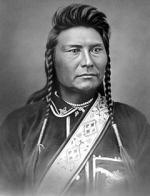Disable ads!
Chief Joseph
Hinmatóowyalahtq it (Chief Joseph) Native name Hinmatóowyalahtq’it Born (1840-03-03)March 3, 1840 Wallowa Valley, Oregon Died September 21, 1904(1904-09-21) (aged 64) Colville Indian Reservation, Washington, United States Cause of death Natural causes, "A broken heart", according to his doctor Resting place Nespelem, Washington Other names Chief Joseph Joseph the Younger Young Joseph Predecessor Joseph the Elder (father) Spouse(s) Heyoon Yoyikt Springtime Children Jean-Louise (daughter) Parents Tuekakas (father) Khapkhaponimi (mother) Relatives Sousouquee (elder brother) Ollokut (younger brother) four sisters Signature The Nez Perce reservation in 1855 (green) and the reduced reservation of 1863 (brown). Hin-mah-too-yah-lat-kekt, Hinmatóowyalahtq it in Americanist orthography, popularly known as Chief Joseph, or Young Joseph (March 3, 1840–September 21, 1904), succeeded his father Tuekakas (Chief Joseph the Elder) as the leader of the Wal-lam-wat-kain (Wallowa) band of Nez Perce, a Native American tribe indigenous to the Wallowa Valley in northeastern Oregon, in the interior Pacific Northwest region of the United States. He led his band during the most tumultuous period in their contemporary history when they were forcibly removed from their ancestral lands in the Wallowa Valley by the United States federal government and forced to move northeast, onto the significantly reduced reservation in Lapwai, Idaho Territory. A series of events that culminated in episodes of violence led those Nez Perce who resisted removal including Joseph's band and an allied band of the Palouse tribe to take flight to attempt to reach political asylum, ultimately with the Lakota chief Sitting Bull in Canada. They were pursued by the U.S. Army in a campaign led by General Oliver O. Howard. This 1,170-mile (1,900 km) fighting retreat by the Nez Perce in 1877 became known as the Nez Perce War. The skill with which the Nez Perce fought and the manner in which they conducted themselves in the face of incredible adversity led to widespread admiration among their military adversaries and the American public. Coverage of the war in United States newspapers led to widespread recognition of Joseph and the Nez Perce. For his principled resistance to the removal, he became renowned as a humanitarian and peacemaker. However, modern scholars like Robert McCoy and Thomas Guthrie argue that this coverage, as well as Joseph’s speeches and writings, distorted the true nature of Joseph’s thoughts and gave rise to a “mythical” Chief Joseph as a “red Napoleon” that served the interests of the Anglo-American narrative of manifest destiny.
 Read more on wikipedia.org Read more on wikipedia.org
 All quotes by Chief Joseph All quotes by Chief Joseph
 Edit Edit
|

|
|
|
|
|
Background photo by Giuliana
|